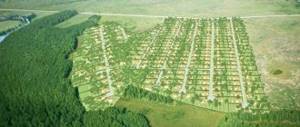Form of land plot location diagram
The preparation of the scheme must be carried out in the form of an electronic document.
However, in some cases provided for by the Code and other regulations adopted on its basis, it is also possible to provide the scheme in paper form.
In particular, when it comes to preparing a scheme, which is carried out by the citizen himself personally, to provide him with a plot of land without holding a tender or auction, the preparation can be carried out in two forms:
- in the form of an electronic document;
- on paper.
When preparation in the form of an electronic document is necessary, you can use a special service on the website of your regional cadastral chamber office. In addition, it is possible to draw up a diagram using special programs and software that are installed on a personal computer.
It is worthwhile to dwell separately on drawing up a diagram using the cadastral chamber website. Preparation of a document in this form can be carried out by any person for a fee. The exact amount of payment and the procedure for collecting it are established at the level of the Government of the countries.
Sample diagram for individual housing construction
In essence, it is a plan of a plot of land on the ground. Moreover, it must indicate both all existing buildings and those being designed. Since a sample of the SPOZU is often required precisely to begin construction, the main attention should be paid to the drawing of the future house and other structures that are supposed to be built on the territory.
Always consists of 3 parts:
- Drawing on a scale of 1:500 (in 1 cm of the diagram there are 500 cm of real space, i.e. in 1 cm of “paper” there are 5 meters of territory).
- Conventions.
- Technical and economic indicators. They characterize the parameters of the building to be constructed, as well as the area of the territory:
- total area of the house;
- total area within the inner surface of the walls;
- area by floors;
- total number of floors;
- building height;
- building density coefficient (it should be within 0.40);
- development coefficient (no more than 0.20).
As a rule, under the drawing there is a tabular part in which the following data is indicated:
- Full name, developer position;
- his signature;
- date of creation of the scheme;
- who approved the SPOSU;
- information about the customer;
- scale;
- total number of sheets;
- the number of this sheet.
The diagram must indicate the dimensions of the house and the distances of the external walls from the boundaries of the site
. All data is given in meters.
Detailed video commentary on building codes for indentations:
Expert opinion
Salomatov Sergey
Real estate expert
In SPOZU only permanent buildings are designated. Bathhouses, garages, greenhouses, and other outbuildings are not taken into account.
Coordination and approval of the layout of the land plot
The finished scheme is subject to mandatory approval by authorized bodies. In particular, the finished document, executed in electronic or paper form, must be agreed upon:
- executive authority of a separate subject of the state;
- local government body.
This rule, by agreement, applies in all cases, with the exception of some established at the legislative level.
Based on the results of reviewing the scheme, the authorized body makes a decision that can either approve it or imply a refusal to approve it.
Requirements and documents necessary for drawing up a site layout plan
The basic requirements for preparing a land plot layout diagram are presented as strict compliance with the established list of documents. If at least one regulatory legal act is missed during production, the finished work may be declared invalid due to its non-compliance.
In order for the scheme to meet all established legal requirements, during its preparation, as well as subsequently, during its approval, the use of the following package of documents is required:
- documents on territorial planning in a given area;
- rules for land use and development;
- project of the future layout of a specific territory;
- land management documentation;
- resolutions designating a specially protected area;
- regulations identifying zones with special conditions for the use of the territory;
- documents on plots intended for public use;
- resolution on the location of plot boundaries;
- regulations containing data on the location of buildings and structures within the boundaries of a certain territory.
Legal standards
The procedure for putting a capital construction project into operation is regulated by legislative norms that require strict implementation of all prescribed measures.
Other regulations are drawn up taking into account the requirements of this document. They supplement it with certain provisions, but do not deviate from the norms of this law. The regulations reflect all issues related to obtaining permits, without which it is impossible to officially put a building or structure into operation. There you can find a list of documents, instructions for filling them out, and approved permit forms.
State construction supervision scheme
Enough information can be gleaned from the current SNiPs, which regulate the commissioning of objects of various categories, each of which has separate requirements. When carrying out the operation, regional regulations should be taken into account.
The procedure for consideration and decision-making on the commissioning of capital construction projects
To obtain permission, without which it is prohibited to operate the building, you must act in accordance with a certain algorithm. You need to follow these steps step by step:
- Submit an application.
- Prepare a package of documentation that is an attachment to the application.
- Write a cover letter attaching a diagram of the facility, which should show the communications plan for the utility networks installed on the land plot in question.
- Submit an application to a specialized organization.
The decision to enter the building into the registry database relating to cadastral registration, or to refuse to carry out the event, is made by representatives of the authorized bodies after considering the application with a set of documentation.
Application and documents for approval of the site plan
The department of architecture and urban planning will need to provide the following package of documents:
- a statement containing a request for approval of the drawn up scheme;
- identification document of the applicant;
- if necessary, a certificate of registration of the applicant as an individual entrepreneur;
- certificate that the applicant has carried out cadastral registration;
- if necessary, a power of attorney;
- preliminary conclusion issued by the deputy head of the local administration;
- cadastral plan of the given territory;
- an act confirming that the postal address has been established;
- minutes of the meeting on the provision of plots;
- exact layout of the land plot;
- documents confirming ownership.
The decision made by the authorized body of the subject or city of the state in relation to each specific plot of land must contain information:
- about the exact area of each specific plot of land;
- about the exact address of each site. If it is impossible to indicate the address, it is necessary to create a description of the location of the site;
- about the cadastral number of the plot. In the case when one single plot of land is formed from several plots, the cadastral number of each initial plot is required;
- about the territorial zone within the boundaries of which the site is being formed. In a situation where the new site is not subject to special urban planning regulations or is not established for it, it is required to indicate the exact type of use of the land;
- about the category of land to which the new plot will belong.
The full validity period of this decision is two calendar years.
What is a cadastral plan
In the context of the country's territory, the concept of ownership of land and buildings on it is distributed among the owners. Legally, receiving a site plan and passport gives the right of ownership. But no less important is this: such a decision imposes responsibility for maintaining one’s own property and preventing a negative impact on adjacent areas. New status of lands - new legal, environmental and technical relations will be formalized.
It is important that as a result of construction on the owner’s property, conducting farming activities or achieving other goals permitted in the cadastral plan, it will not cause any claims from neighbors and harm to adjacent areas, including those located at a considerable distance (for example, the discharge of pollution into river or release of toxic substances into the atmosphere).
We recommend that you read:
Why do you need to draw up a land survey plan and where to get it?
Where to get a cadastral plan of a land plot is not particularly important. Whenever you contact a competent government agency (most simply, the nearest multifunctional center), the result will be the work of the Rosreestr departments, and upon the allocation of a land plot to a citizen or organization, the information will be included in a single database.
It is not a problem to register ownership of land to build a residential building, create a farm, or improve a fishermen’s recreation area. The question is time and preparation of the appropriate package of documents.
The cadastral plan itself is:
- Information about the body that prepared the cadastral plan.
- Data on land allotment.
- Unique (identification) number of the site.
- Date of registration.
- Confirmation of the owner's rights.
- Territorial location of the site.
- Description of adjacent territories.
- Purpose of land use.
This is the general part of the cadastral plan, containing essential positions. Essentially, it is of a targeted and registration nature. The graphic section of the plan (layout) is a diagram of the boundaries of the allocated territory indicating the dimensions, landmarks and adjacent territories. The existing encumbrances of the site are described.
The cadastral plan of a land plot is an absolutely accurate description of the property and its owner. The information is unique, placed in a unified state register and is publicly available, it can be freely viewed if necessary, and has legal force. In order to subsequently redo or clarify data, compelling reasons will be required.
Refusal to approve the layout of the land plot
The following situations may be used as grounds for refusal of approval by authorized bodies of a scheme submitted to them:
- the authority identified a discrepancy between the layout of a plot of land and its form, format or preparation requirements established at the legislative level.
- if during the inspection it was revealed that the site located on the diagram has a complete or partial coincidence in its location with another site approved on the scheme, the validity of which has not expired.
- if it was revealed that the layout of the land plot on the cadastral plan was developed with violations of the information established for this event.
- when a discrepancy is identified between the location of the site on the diagram and on the accepted plan of the given territory.
- when the site is located on the territory for which the boundary plan has been approved.
What is it needed for
The grounds for registration and registration of ownership of a land plot are dictated by life, business activity or other socially useful purposes. A cadastral plan of a land plot may be required for the construction of a memorial to combatants or a reserve for endangered species of flora and fauna that were discovered completely unexpectedly in a place unsuitable for their survival, and it is necessary to restore their usual habitat.
The target function of using a land plot determines the registration procedure and what probable preliminary actions will look like, which outwardly have nothing to do with the question: how to obtain a cadastral plan of a land plot (place an order).
The functionality of engineering structures that will need to be erected, or the peculiarities of land use and care may affect the surrounding areas and harm the legitimate interests of the owners of nearby properties. The reverse influence of adjacent lands on the site of interest to the future owner is also taken into account. Government officials are required to issue documents and take all actions to distribute, register and formalize land in the manner prescribed by law.
Before starting the procedure for registering a land plot, you should compare the goal to be achieved, the period of conditions for achieving it, take into account that you will have to order paid services, invite an engineer for land surveying with objective reality.
The definition of reality includes the following:
- geography of the area and its population;
- location of nearby residential buildings, industrial structures, engineering structures;
- the presence of harmful emissions in the reach area (by air, water, land);
- the presence of strict environmental requirements;
- specific climate of the area, features of the physical and chemical composition of nearby lands;
- the presence of mountains and reservoirs, the likelihood of natural disasters.
- legal status of the future owner.
Only in the ideal scenario (allocation of a plot of land in a city, a populated holiday village, or in an engineered settlement) there will be no particular problems with registering a land plot (everything can be done quickly online). But it’s still not worth discounting the Internet with unstable access, power outages, the nearby cattle breeding complex and wind dynamics on different days of the week and different times of the year.
The Internet can become an urgent need for growing children, and elderly parents can be harmed by the specific smell from a livestock breeding complex. It’s one thing when land is needed for industrial premises (non-residential use), a completely different situation when land is needed in order to live.









